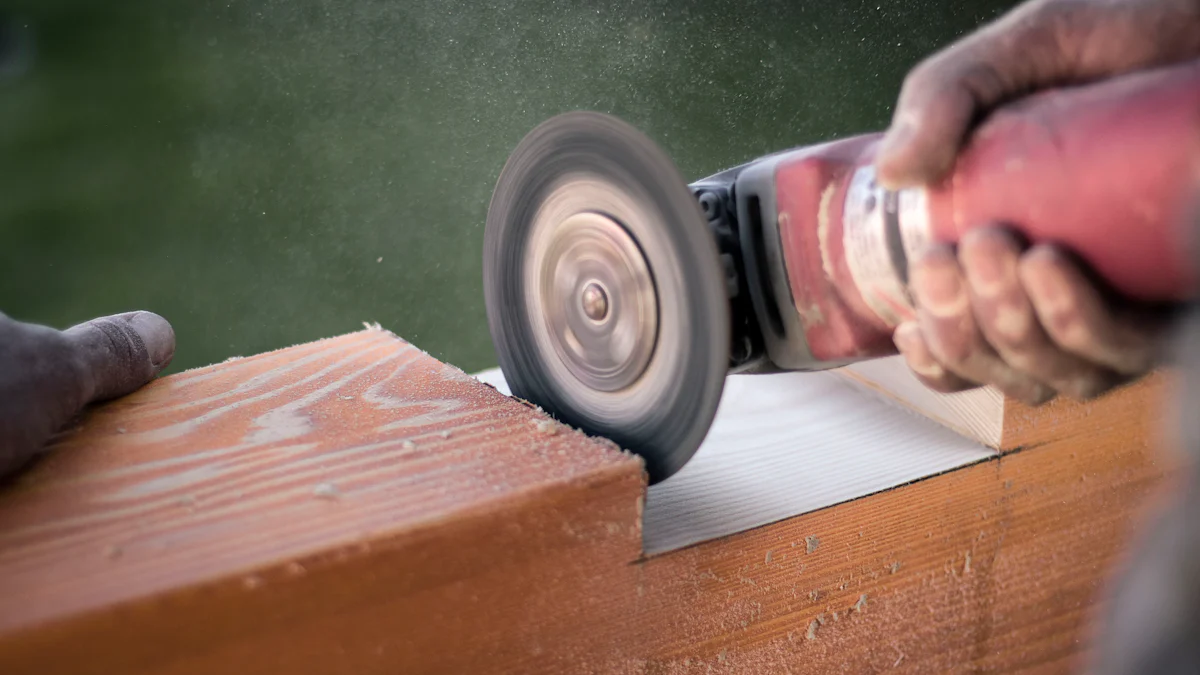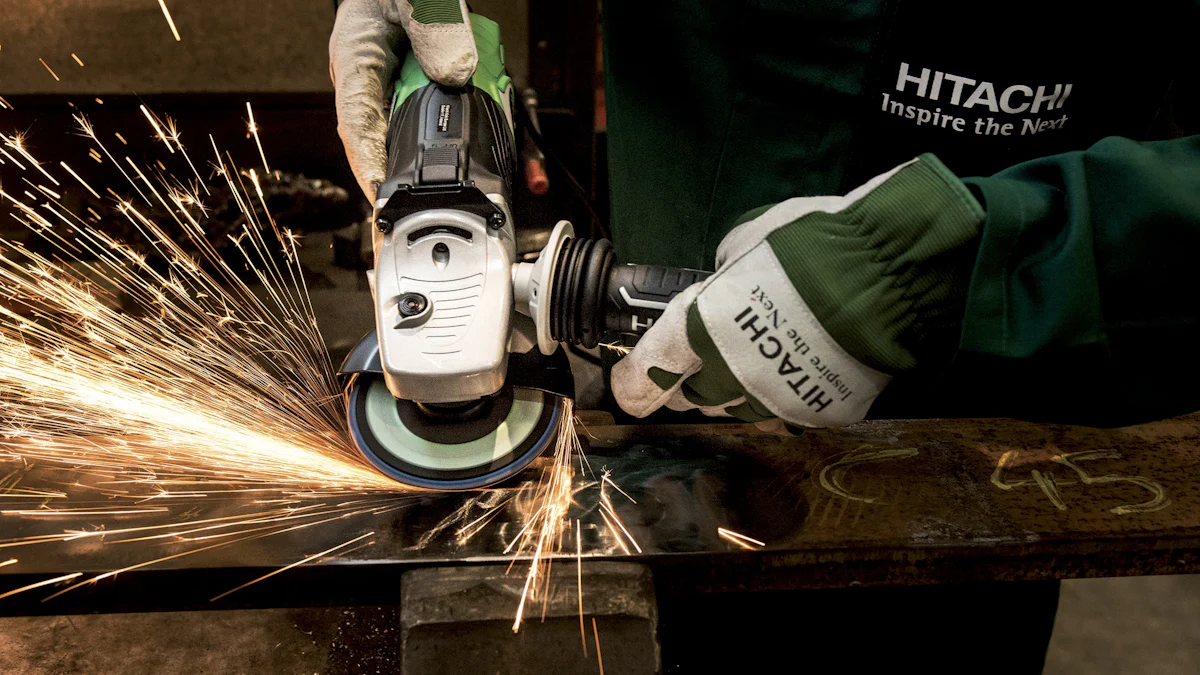
Safety plays a crucial role in metal cutting. Every year, nearly 400,000 emergency room visits occur due to power tool injuries. Small metal cutting tools require careful handling to prevent accidents. These tools include drill bits, end mills, and taps. Improper use can lead to breakage or failure. The purpose of this blog is to provide essential safety tips for using these tools effectively. Proper usage ensures not only personal safety but also enhances the efficiency of your work.
Understanding Small Metal Cutting Tools
Types of Small Metal Cutting Tools
Handheld Tools
Handheld tools offer precision and control for metal cutting tasks. Hacksaws are a popular choice. These tools have fine-toothed blades designed for cutting metal. Secure the metal in a vise or clamp before using a hacksaw. Start with a light stroke to create a groove. Gradually apply more pressure to cut through the material. Patience is key to avoid premature wear on the blade.
Hole saws attach to drills or drill presses. These tools cut circles in metal sheets. Bi-metal hole saws provide versatility for different metals. Always ensure the workpiece is stable to prevent movement during cutting.
Power Tools
Power tools enhance efficiency in metal cutting. Circular saws can adapt for metal cutting with the right blade. Metal-cutting blades feature carbide teeth or abrasive discs. Securely clamp the material to a stable surface before cutting. Adjust the saw’s depth to minimize kickback risk. Circular saws require careful handling to ensure safety.
Applications of Small Metal Cutting Tools
Industrial Use
Small metal cutting tools play a vital role in industrial settings. Factories use these tools for precision cuts in manufacturing processes. Power tools like circular saws increase productivity. Industries rely on these tools for tasks requiring accuracy and speed. Proper tool selection ensures compatibility with the metal type. Regular maintenance keeps tools in optimal condition.
DIY Projects
DIY enthusiasts benefit from small metal cutting tools. Handheld tools like hacksaws offer control for home projects. Hobbyists use these tools for crafting and repairs. Power tools provide efficiency for larger tasks. Safety measures, such as wearing protective gear, are crucial. DIY projects require proper planning and tool selection for success.
Safety Measures for Using Small Metal Cutting Tools

Personal Protective Equipment (PPE)
Eye Protection
Always prioritize eye protection when using a small metal cutting tool. Metal shards can cause severe eye injuries. Safety goggles or a face shield will protect your eyes from flying debris. Choose eyewear that meets safety standards for impact resistance. Ensure a snug fit to prevent particles from entering around the edges. Regularly inspect your eye protection gear for scratches or damage.
Hand Protection
Proper hand protection is essential when handling small metal cutting tools. Wear heavy-duty gloves to shield your hands from sharp edges and hot surfaces. Select gloves that offer a balance between dexterity and protection. Ensure the gloves fit well to maintain control over the tool. Inspect gloves for wear and tear before each use. Replace damaged gloves immediately to ensure safety.
Safe Handling Practices
Proper Tool Grip
A firm grip on a small metal cutting tool ensures precision and safety. Hold the tool with both hands for better control. Position your hands away from the cutting path to avoid injury. Use a vise or clamp to secure the workpiece. This allows you to focus on controlling the tool. Avoid gripping the tool too tightly, which can lead to fatigue.
Safe Cutting Techniques
Adopt safe cutting techniques to enhance efficiency and reduce risks. Begin with a light stroke to create an initial groove in the metal. Gradually increase pressure as the cut progresses. Maintain a steady pace to prevent tool binding. Keep the cutting area clear of obstructions. Regularly check the tool for signs of vibration or unusual noise. Address any issues before continuing the task.
Expert Testimony:
“Before starting any project, familiarize yourself with the safety features of your power tool. This includes understanding how to handle the tool properly and using the appropriate personal protective equipment (PPE).”
A clean and organized workspace minimizes accidents. Remove any flammable materials from the vicinity. Ensure adequate ventilation to disperse dust and fumes. Follow manufacturer instructions for each small metal cutting tool. Regular practice and adherence to guidelines improve safety and results.
Techniques for Effective Metal Cutting

Tool Selection
Material Compatibility
Selecting the right small metal cutting tool requires understanding material compatibility. Different metals require specific tools to achieve clean cuts. For example, aluminum needs a different blade than steel. Using the wrong tool can damage both the tool and the material. Always check the manufacturer’s guidelines for tool compatibility with various metals. This ensures effective cutting and prolongs the life of the tool.
Tool Sharpness
Tool sharpness plays a crucial role in effective metal cutting. A sharp small metal cutting tool provides cleaner cuts and reduces effort. Dull tools can cause accidents and damage the workpiece. Regularly inspect tools for sharpness before use. Sharpen or replace blades as needed to maintain efficiency. Proper maintenance of tool sharpness enhances safety and performance.
Cutting Techniques
Straight Cuts
Straight cuts require precision and control. Secure the metal piece firmly to prevent movement. Use a ruler or guide to mark the cutting line. Start with a light stroke to establish a groove in the metal. Gradually increase pressure while maintaining a steady pace. A small metal cutting tool like a hacksaw or circular saw works well for straight cuts. Ensure the tool remains aligned with the marked line for accuracy.
Curved Cuts
Curved cuts demand careful handling and technique. Select a small metal cutting tool designed for curves, such as a jigsaw with a metal-cutting blade. Secure the workpiece to avoid slipping during the cut. Mark the curve clearly on the metal surface. Begin with a slow, controlled motion to follow the curve accurately. Adjust the tool’s angle as needed to maintain the desired path. Patience and practice improve skill in making curved cuts.
Scientific Research Findings:
- Metal Cutting Tools in Manufacturing Industry highlight the importance of removing leftover material using shear deformation. This principle applies to both straight and curved cuts.
Maintenance of Small Metal Cutting Tools
Proper maintenance ensures the longevity and effectiveness of a small metal cutting tool. Regular care prevents damage and enhances performance. Follow these guidelines to keep your tools in top condition.
Cleaning and Storage
Cleaning Procedures
Clean a small metal cutting tool after each use. Remove debris and metal shavings with a brush or cloth. Use a mild solvent for stubborn residues. Avoid water to prevent rusting. Dry the tool thoroughly before storage. Regular cleaning keeps tools sharp and ready for the next task.
Proper Storage
Store a small metal cutting tool in a dry, cool place. Use protective cases or covers to shield blades from dust and moisture. Organize tools on racks or shelves to prevent damage. Ensure that tools are not stacked or piled. Proper storage maintains tool integrity and readiness.
Regular Inspection and Repair
Identifying Wear and Tear
Inspect a small metal cutting tool regularly for signs of wear. Check blades for dullness or chips. Examine handles for cracks or loose parts. Look for rust or corrosion on metal surfaces. Early detection of wear prevents accidents and prolongs tool life.
Repairing or Replacing Tools
Repair a small metal cutting tool if possible. Sharpen dull blades using appropriate sharpening tools. Tighten loose screws or bolts. Replace damaged parts with manufacturer-approved components. If repair is not feasible, replace the tool entirely. Keeping tools in good condition ensures safety and efficiency.
Patents and Technical Documents reveal innovations in metal cutting tools. Improvements enhance tool durability and functionality. Following maintenance procedures aligns with these advancements. Proper care maximizes the benefits of modern tool designs.
Safety and technique play a vital role in using a small metal cutting tool. Always prioritize safety to prevent accidents. Proper techniques ensure efficient and effective cuts. Practice safe tool use to protect yourself and others. Chad McDade emphasizes, “An important part of properly using a tool is knowing how to use it safely.” This knowledge extends the life of your small metal cutting tool. Regular maintenance keeps tools in top condition. High Country Lumber states, “Proper use of power tools involves more than knowing how to operate them.” Maintenance ensures longevity and performance. Follow these guidelines for a safe and productive experience with your small metal cutting tool.
